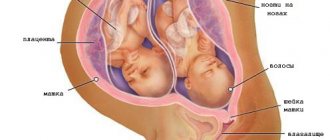Features of infant development
In order to understand this issue, it is necessary to understand how young children develop.
During the first year of life, the child’s spine is at the stage of formation, gradually acquiring curves and acquiring muscles.
- In the first 3 months, the baby’s spine is absolutely straight, so the baby needs to remain in a lying position.
- By 3-4 months, the first cervical curve is formed. The child holds his head confidently.
- At 6-7 months of life, the thoracic region is formed. The baby tries to sit up.
- After about 9 months, the lumbar region begins to form. The child learns to stand and walk.
It often happens that we forget ourselves while playing with the baby, sitting him down or putting him on his feet. Orthopedists say that this is very harmful for the still fragile spine.
Pediatricians recommend to young parents:
- do not sit the child down until he begins to sit down confidently;
- Do not put the baby on his feet without support until he learns to stand up without adult help.
At approximately 5-7 months, most children begin to try to sit up on their own. They choose a position that is favorable for this, so that there is an opportunity to lean on something. When the desired intention can be realized, the kids experience genuine delight. The new position significantly expands the overview. That is, when a child sits, he has more new opportunities to explore the world around him.
Main differences in development
It is a well-known fact that girls develop faster than boys.
On average, boys are delayed by about 3-4 weeks, sometimes even several months, although boys are heavier and taller at birth.
However, not only physiological, but also other features are important.
- First of all, of course, the physiological development of girls affects the age at which they can sit down. The skeletal system in female infants is more fragile, and it strengthens much more slowly than in boys. In addition, the muscular system of girls is weaker: this persists throughout life, because, as is known, men have more muscle, and women have more adipose tissue.
- Features of emotional perception. Girls are more sensitive to emotions; they need a lot of affection, tenderness, and warm words even in infancy. If parents are not gentle with their daughter, try to communicate with her as with an adult, and pay little attention, the girl may simply not be ready to take the next step in development.
- Psychological nuances. When parents are in a hurry to raise a child, to quickly teach the baby to walk, crawl, sit, she may experience psychological fear of demanding parents. So, the harder and harder the parents try to force their daughter to sit down, the more afraid she will be of this.
Should I sit my baby down until he is six months old?
Orthopedists and pediatricians are unanimous on this issue. Experts are categorically against early artificial sitting of babies. During play, you can allow the baby to take a semi-sitting position, but only if the child comes to this on his own. As a rule, the baby remains in this position for only a few minutes until he gets tired. After which he also independently changes his position.
A child, having learned to sit with support, begins to practice a new skill more and more often. This makes it more convenient to observe what is happening in the room. It is pointless to vigilantly monitor the baby and constantly change his position, putting him back in bed. The baby will persistently strive to sit down again, you will only be exhausted with him. Plus, constant interventions in this case will slow down the development process. And at the same time, children at such an early age cannot sit for a long time. Even if your five-month-old baby begins to sit down without any help, you need to make sure that he is in this position for no more than an hour a day.
What signs can be used to determine a child’s readiness?
The formation of the skill of sitting in children occurs gradually. From the age of six months, many girls begin to make their first attempts to give their back a vertical position.
Due to the weakness of the muscle corset, this turns out badly for them: the babies immediately fall to the side or back. But there are exceptions when a girl already at six months can maintain her balance well in a sitting position and reach for objects that interest her. At seven months of age, babies begin to sit more confidently.
They manage to maintain balance well and not rely on their hands. Many people know how to sit down from a position on all fours. But babies stay in this position for a short time. At 8-9 months, girls can sit up from any position.
To do this, they no longer need the support and support of an adult. Little ones can sit for a long time and not get tired. But the development of a new skill in girls does not always take place within the time frame indicated above. A delay of 1-2 months is not critical. Parents can help the baby by sitting her down.
Sitting down boys and girls. Is there a difference?
Many are absolutely sure that boys can be seated before they try to do it on their own, but girls are strictly forbidden to sit down at all. In fact, this is a myth. Pediatricians do not differentiate children by gender in this matter. Here you need to refer to the physical training of each individual child, to his individual characteristics.
According to doctors, in the development of children we need to focus on approximately the following indicators:
- 6 months - baby sits with support
- 7 months - sitting without support
- 8 months – sits up easily and can easily lie down from a sitting position
Very active and physically strong children can sit down a month and a half earlier. Some, on the contrary, later. In these cases, there is no need to panic. This is also the norm.
Tips for parents
Evgeny Olegovich Komarovsky advises parents who want to quickly teach their daughter to sit, to motivate her to crawl.
A well-known children's doctor considers this more effective than sitting down. During such physical activity, the muscles of the whole body are strengthened: the abs, neck, back, arms and legs. The child will soon begin to sit up on his own.
To stimulate crawling, a well-known pediatrician recommends:
- spread a warm blanket or blanket on the floor;
- put the baby on the blanket on his stomach;
- place a bright toy at some distance from the child;
- the girl will try to get to the object of interest to her by crawling.
How to determine that the baby is completely ready to sit down?
This is indicated by the following factors:
- the baby easily changes his lying position: rolls over from his stomach to his back and, conversely, from his back to his stomach;
- holds his head well, can lift it from a horizontal position;
- feeling support, he stands confidently on his feet;
- tries to get up on his own;
- by grasping the fingers of mom or dad, he can take a vertical position
.
It is impossible to say exactly how many months a child starts sitting. Each baby has its own term, since the level of development is different for everyone. Parents should remember that sitting down a child early can have a negative impact on his or her health later. An upright position is unnatural for a baby until he reaches six months. Until the child sits down on his own, there is no need to try to teach him to do this. Artificial sitting can lead to serious problems with the spine. As soon as the back muscles are sufficiently strong, the child himself will begin to make attempts to take a sitting position.
Exercises that are good for your child's back
- Place the baby on his back. Grab it by the handles (or let your fingers grab it) and gently, slowly lift it into a semi-sitting position. Do not make sudden movements, do not try to immediately seat the child. His back should only rise a few centimeters above the surface.
- Do the same exercise from a lying position on your stomach so that your back arches slightly. The adult must stand in front of the child so that he can see him.
- Place your baby on his stomach and stand behind him. Let him rest his feet on your stomach. Support your baby under your chest with one hand and place the other between your legs. Slowly and carefully lift the child above the surface, hold for a few seconds and lower down. Repeat several times.
- This exercise is suitable for babies who can already crawl. Place your baby on his stomach on the floor. In front of him, at a short distance, place a bright toy, maybe several. The child will become interested and crawl towards the toy and, if he is lucky, when he takes it in his hand, he will involuntarily sit down.
- Fitball exercises. Place the baby on a large inflatable ball, holding it on all sides, and let it fidget and move its arms and legs.
- Place your baby on his stomach with his legs facing you. Let him grab onto your fingers. Make movements with your hands so that his shoulders are raised and his shoulder blades are brought together (forward, upward, towards the table, along a semicircle trajectory).
Muscle strengthening
You can strengthen the muscles that will be involved in the process of sitting down with the help of massage and a set of exercises. These procedures must be performed on a hard surface (changing table or laid floor), and they must be carried out regularly, starting from 3-4 months. As soon as the child’s muscles are sufficiently strengthened and he begins to actively roll over and crawl, this is a signal that you can try to sit him down.
Stretching exercises
Such exercises are designed to strengthen the muscles of the back, buttocks and tummy, and also prepare the baby’s hands for the process of turning over and crawling. After mastering these skills, the baby will begin to try to sit up within a month.
- You can place bright objects in front of a baby lying on his tummy, encouraging him to reach out to them with his hands;
- You can hang rattles above the crib or in the stroller, which the baby will try to reach for;
- When the baby is lying on his back, put your index fingers in his arms and, as soon as he grabs them tightly, gently pull them towards you, encouraging the baby to pull himself towards you.
Swimming
Exercising in water strengthens not only the muscular corset that a child needs to sit up on his own, but also his entire musculature. You can sign up with your baby in the pool and train with an instructor, and if there are no specialized groups in the city for joint activities with babies, then let the baby swim at home with a circle in the bathroom.
You can start swimming after the first month of life, as soon as the umbilical wound heals . Water procedures will help relieve the newborn's tone and strengthen the muscles necessary to learn to roll over, crawl, sit and walk.
Massage
Preventive massage of the back and buttocks is also great for strengthening the muscles that are used when children sit down. The procedure can be carried out by a paid specialist at home; after a professional course, children begin to master the necessary motor skills much faster than their peers. This measure is suitable for those children who are slightly behind development standards.
If your baby is healthy and developing at a normal pace, you can get by with a regular massage. You can ask a massage therapist or pediatrician at a children's clinic about how to do it correctly, and also read here.
As a rule, children's massage begins with light stroking, then gradually moves into movements with light pressure and ends with soft soothing smoothing of the muscles. Your arms should be directed from bottom to top for “vertical” movements, and from the spine to the sides for “horizontal” movements.
This massage is very simple, but you will notice how many positive emotions it will bring you and your baby. Tactile contact with your hands will calm the baby before bed, and - most importantly - regular sessions will strengthen your child's muscles . Continue the massage sessions as you begin to sit your baby down.
Fitball
Fitball exercises are very useful for the development of a baby’s muscular system. They should be carried out in the first half of the day, 1-1.5 after meals. The baby needs to be undressed and the ball covered with a clean diaper. Work with your baby every day for as long as he can handle without being capricious. The topic of exercises on the ball is covered most fully here.
- Holding the baby, rock him in different directions, either on his tummy or on his back.
- Putting the baby on his tummy and holding him with one hand, lightly press the ball with the other so that it begins to spring; repeat the exercise in a supine position.
- In the tummy position, hold your baby by the legs and roll the exercise ball back and forth.
How can I help develop a girl’s planting skills?
Quite often there are cases - the baby has reached the age when she should acquire this skill, but she still does not sit, and does not even try to learn it. In this case, there should be a mandatory consultation with doctors such as: pediatrician, neurologist, orthopedist. And if these specialists rule out their pathology, then parents should take care of the physical development of their baby and help her acquire this skill.
This is done using:
- restorative massage. It is recommended that in addition to the parents, this manipulation should be performed by a professional for the baby;
Parents should carry out these procedures every morning and before evening bathing.
- swimming. It is better to start playing this sport in the first month of the baby’s life, and then such problems will most likely not arise for your girl. But if there is a place for this, then you can learn to swim both in the bath and in the pool;
Possible complications of early disembarkation of a girl
Moving the baby in a car seat, carrier, or stroller should also be done in a semi-lying state, then there will be no load on the spinal column.
According to medical data, if untimely disembarkation, the baby may experience not only spinal disorders in the form of lordosis, scoliosis, osteochondrosis, but also deformation of the pelvic bones. And this factor can play an important role during childbirth, since due to these changes the birth canal can be deformed and this process will be even longer and more painful.
In addition, when a girl adopts such a position early, her psycho-emotional state may be disturbed and she may be overcome by a feeling of fear.
Jumpers and walkers
About when you can use jumpers, you need to consult a doctor, who first assesses the baby’s physical characteristics. Your baby can begin sitting in a walker or jumper no earlier than he learns to sit confidently on his own.
If at first the child cannot sit upright, then this is not a reason to panic. At first, the baby will lean to the side and lean on his arms while sitting. But this all passes over time, and the child will learn to sit well. There is no need to adjust it, tug it, or sit it straight. He must learn to keep his balance on his own. And new movements for a child are an excellent method of learning everything new, learning about the world.
Preparing your baby to sit
Immediately after discharge from the maternity hospital, the pediatrician obliges the mother to show the baby to different doctors. This is necessary to understand the overall picture, identify pathologies, and determine the physical condition.
As a result, it becomes clear that his development fits into average pediatric norms. This means that you have the right to expect at least average achievements from your child.
Discussions about what time children start walking. Baby's first steps, learning to walk.
How to spend a fun child’s birthday at home, a selection of quests is presented here.
And here we describe the reasons for poor night and daytime sleep in a 6-month-old baby.
Parents' misconceptions about early planting
Do not sit your baby down prematurely, as his body must be ready for this process!
Some parents believe that if:
- The baby is six months old, then she can be planted. This is not true, because artificially seating a child can harm his health in the future. So, in this case, a lag in physical development, poor posture, etc. may occur;
A sign of a baby’s strengthened muscle corset and correct posture is being in a sitting position for a long time, while the baby’s back is straight (not protruding in the form of an arc), the pelvis is slightly tilted anteriorly, and the legs confidently support the body in this position.
- sit down girls too early - a posterior bend of the uterus may form. This theory has been refuted by medicine, since this factor has either a genetic predisposition or is a consequence of a previous infectious-inflammatory process.
- The baby is in the jumpers, it is safe for the child and they do not pose any threat to the health of the baby. This opinion is incorrect, since the child’s spine experiences an enormous load, being in an upright position with a poorly formed muscular frame and a fragile spinal column;
Yes, this device “helps out” the mother a lot, giving her the opportunity to go about her business, but you shouldn’t use it at least until the baby has learned to sit, or better yet stand, and the most correct thing is not to use them at all.
- The baby begins to stand and walk in a walker, then she will walk faster. This theory is erroneous because, firstly, when walking independently, a different group of muscles is used, so after this such children often move on their toes. Secondly, in this device, strengthening of the back occurs in an unnatural way (this process best occurs while crawling). Thirdly, the child does not develop the awareness that without them he will fall. And when trying to stand without support, he may get injured or begin to be afraid to move independently.
It is better not to use this device, but if this is not possible, then use it at least from the age of eight months.
What not to do?
It is prohibited to do the following things during the planting process:
- abruptly transfer the child from a vertical to a horizontal position. This is a serious load that has a bad effect on a fragile child’s body;
- sit the baby down for a long time. The first classes should take place within a few seconds. You need to increase the duration of training gradually;
- bend your legs strongly. During the first lessons, the baby should be in a reclining position;
- force events. If a child does not sit independently, he cannot be transported in strollers with a vertical backrest, supported under the bottom, placed in jumpers, walkers, car seats, kangaroo-type devices, etc. During feeding, hygiene procedures, games, reading, traveling in the car and public transport, the baby should recline;
- letting the baby's development take its course. The speed at which various skills are learned depends on how much time parents spend with their child. Lack of exercise, massage, swimming will lead to the fact that the baby sits up much later than his peers.










